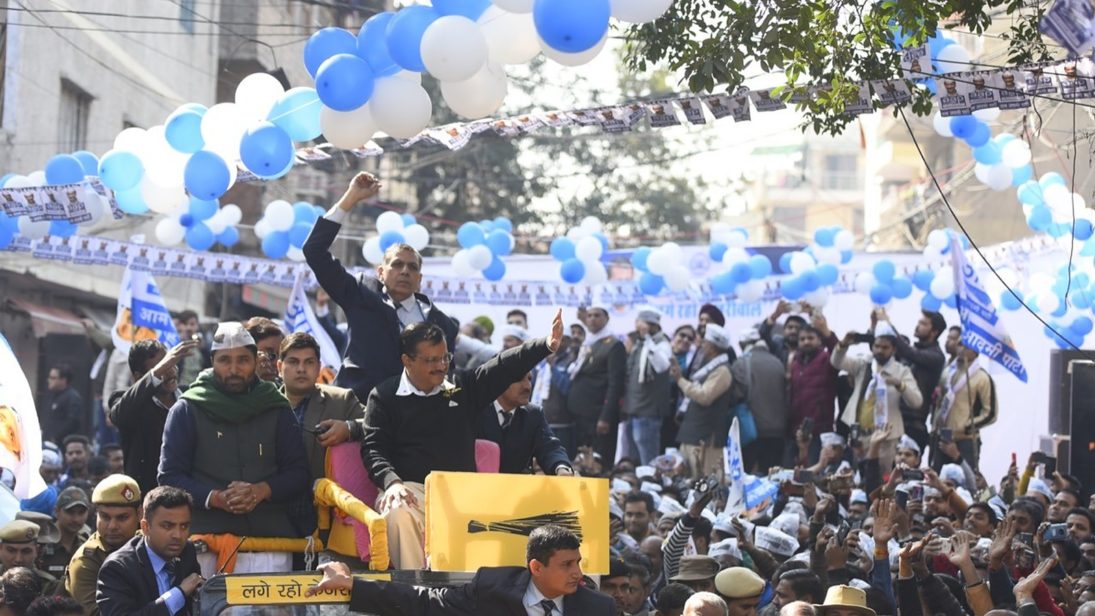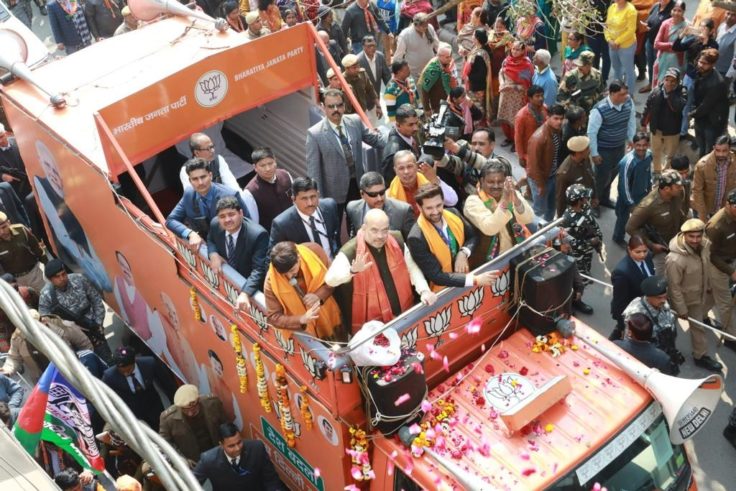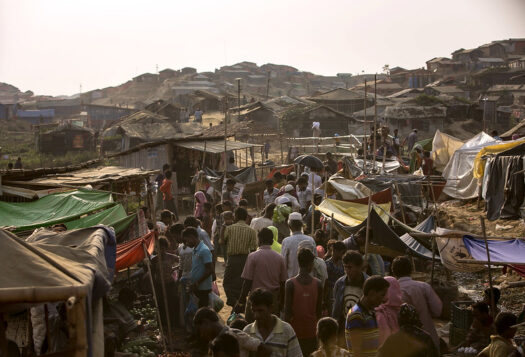
The results of the most recent Delhi elections seem to suggest that development-focused politics can beat out the wave of majoritarian right-wing identity politics in India—at least at the state-level. In last month’s contest between the Aam Admi Party (AAP) and India’s governing Bharatiya Janata Party (BJP) the AAP came to power again in Delhi securing a thumping majority of 62 seats while the much larger national party was limited to the remaining eight.
In the lead up to the election, the BJP largely relied on Hindu-Muslim fault lines and polarization surrounding the controversial Citizenship Amendment Act (CAA), while the AAP, led by Chief Minister Arvind Kejriwal, focused on its achievements in the city-state during its five-year tenure. Such a decisive victory in an election where religious and ideological identity was broadly pitted against a policy- and development-oriented approach may offer a blueprint for other regional parties challenging the BJP. While the development-driven agenda might not be sufficient to unseat the BJP in the 2024 general elections, the results may suggest voters’ new priorities.
Such a decisive victory in an election where religious and ideological identity was broadly pitted against a policy- and development-oriented approach may offer a blueprint for other regional parties challenging the BJP. While the development-driven agenda might not be sufficient to unseat the BJP in the 2024 general elections, the results may suggest voters’ new priorities.
When development matters
Such a clean sweep by a single party against the BJP after the latter’s resounding victory during the 2019 Indian elections is noteworthy. The BJP was confident of winning more than 45 seats in Delhi, as voiced by former BJP president and current Home Minister Amit Shah. However, the BJP fell considerably short of this number despite bringing in 240 members of parliament to campaign, at times door-to-door, during the last leg of the campaign. Even when the exit polls handed AAP the majority, the BJP brushed this aside saying exit polls were “not exact.” While analysis since has debated the significance of the BJP’s loss, the extent and tone of the BJP’s campaign underscores the importance of the Delhi elections to the party, particularly in negating the nationwide anti-CAA protests that gripped the country in the run up to the elections.
To unwrap the people’s mandate in Delhi, it is important to focus on the two main contending parties and the subtext of their respective election campaigns. Beyond differences in the tone and approach of their messaging, the central theme of the AAP’s campaign was grassroots issues and policies that affect the daily lives of the 20 million people inhabiting the city. In its campaign the party focused on achievements in healthcare, education, and access to civic amenities, such as water, electricity and transportation. In five years, the AAP government has setup 450 clinics across 158 locations, which have reportedly treated over 16 million patients. Its scheme of providing free electricity to households consuming less than 200 units has not only put more money in the pockets of poor families but also provides an incentive to use electricity more judiciously. Initiatives like these are especially important in a city that is home to more than 1.6 million living below the poverty line.
The BJP’s strategy: Polarization and Leveraging the new waves of migration
The BJP last held the mantle in Delhi between 1993 and 1998. Consequently, the party had limited ability to dig into its past laurels when it came to the city’s growth and infrastructure. Instead, the BJP with its 40-star campaigners, including Amit Shah and Prime Minster Narendra Modi, tried to appeal to voters on two factors.
The first, was a combination of relying on Modi’s leadership as well as cashing in on the visible religious and ideological fault lines. The polarizing and nationalist rhetoric during the Delhi elections built off the broader change in the BJP’s 2014 and 2019 messaging in the general elections. While in 2014 the Modi campaign was driven by promises of development in 2019 the rhetoric had taken a distinctively more nationalist turn, focused on the conflict with Pakistan and underlying Hindutva ideology.

The second, and less discussed strategy was the BJP’s effort to leverage the new migration patterns in Delhi. The city-state has the second-highest inter-state migration and the highest percentage of migrants compared to its populations—with 38% of its population born outside Delhi. Post-partition, Delhi provided shelter to many facing the brunt of the division and well as waves of forced migrants from the North. But in recent years the demographics of migrants have changed and today two out of every three migrants are from Uttar Pradesh (UP) or Bihar. As per the 2011 census, more than 4 million people hailing from these two states have made their way into the city in the hopes of better job prospects.
Therefore, it comes as no surprise that the BJP gave the city’s reigns to Manoj Tiwari, a UP-born actor and singer in Bihar’s Bhojpuri film industry with deep association with both UP and Bihar. He was inducted into the party in October 2013 in the run-up to Delhi’s previous state election to mobilize votes from the Bhojpuri-speaking community from UP and Bihar—despite having previously contested and lost on a regional party’s ticket in UP. He has been the BJP President in Delhi since 2016 and has won his Lok Sabha seat from Northeast Delhi constituency in 2014 and 2019, where people hailing from Uttar Pradesh make up nearly 75% of the migrant population.
Although the BJP performed below its expectations in the Delhi elections, part of its election strategy paid off in the Northeast, which has a considerable vote base from Bihar and UP, and where the BJP secured six of its total eight seats. However, while the BJP was able to successfully mobilize voters from a dominant sub-group in Delhi it failed to read the larger local concerns of the state.
Delhi result: Paving the roadmap for other states
In 2015, the AAP was the first party to break the BJP’s electoral wave after securing 67 out of 70 seats in Delhi, but the 2019 general election showed that the pull factor for BJP remained strong nationally. In 2020, the AAP has retained power in Delhi after a significant BJP campaign effort but what does this mean for Indian politics?
At its height in 2018, the BJP directly or through alliances in controlled 21 of 29 Indian states. Despite a strong performance in the 2019 general election, today it rules just 16 states (either independently or in coalition) and has lost out in three of India’s largest states and former BJP strongholds—Rajasthan, Madhya Pradesh, and Maharashtra. This as well as Delhi’s electoral result reflects the Indian voter’s willingness to vote differently at the state and the central level. While ideological leanings might still sway national politics, self-interest and development are key at the state-level. The AAP’s prowess in capitalizing on this can help explain how it received 53.57% of the votes even though it got only 18% in the 2019 general elections.
Though the state losses are not a chink in PM Modi’s armour, they can prove to be a major irritant for the BJP in the long-term. A continued lukewarm performance at the state-level means that the BJP runs the risk of losing its majority in the Upper House of Parliament (Rajya Sabha), where members are elected by the respective state legislatives. The BJP is set to be in power in the Lower House till 2024 but with a continued tepid show it might not be able to retain the essential halfway mark in the Rajya Sabha required to effortlessly pass legislation.
Though the state losses are not a chink in PM Modi’s armour, they can prove to be a major irritant for the BJP in the long-term. A continued lukewarm performance at the state-level means that the BJP runs the risk of losing its majority in the Upper House of Parliament (Rajya Sabha), where members are elected by the respective state legislatives. The BJP is set to be in power in the Lower House till 2024 but with a continued tepid show it might not be able to retain the essential halfway mark in the Rajya Sabha required to effortlessly pass legislation. Despite the significant clout of vote-bank politics in India, political parties cannot solely rely on caste- or religion-based politics—and voters at the state-level may be paying more attention to which policies directly link to their daily life. While it is important to note that the hold of identity-politics may be less pronounced in Delhi, the results have shown how voters chose on the national level is not necessarily a predictor in state elections.
The BJP, however, is unlikely to push aside its polarizing politics—such as support for a uniform civil code, the CAA, and vilification of specific minorities—given some of its resonance with its core constituencies. The wave of divisive politics also seems unlikely to face a single umbrella opposition party. The heydays of a two-party system are long behind and the only current hope for a meaningful opposition is leveraging regionalization and localization of politics. Regional parities—a number of which have strongholds in their respective states—generally have stronger grassroots connections and understanding of the local population’s specific grievances and may be better served to implement welfare- and development-oriented policies to garner support, especially in times of an economic downturn and if they have performed well on development issues during their tenure. With the BJP appearing to take a similar approach to upcoming elections—polarizing politics and party leadership-led campaigns—the Delhi elections may be a useful blueprint and hopeful sign for the regional parties.
***
Image 1: Arvind Kejriwal via Twitter
Image 2: Amit Shah via Twitter


